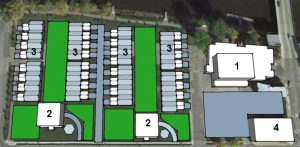City council OKs exploring financing options
By Scott Bellile
In a packed city hall Oct. 16, New London Mayor Gary Henke was surprised by the audience’s clapping following the council’s vote.
“We don’t often get applause,” he told the crowd. “Thank you.”
At that night’s special city council meeting, the council voted 9-1 to proceed with exploring financing options for developing a mixed-use library, residential and commercial development on a 6-acre city-owned property on West Wolf River Avenue in the downtown.
Tom O’Connell voted against the plan.
He told the Press Star after the meeting that he did not receive a concrete answer from the meeting on when the city would have to pay the developer for constructing the library.
“I have great concern because I want to know when we’re going to get that money,” O’Connell said.
Developers have been researching the feasibility of the project for the past year. They presented their take on the project’s affordability to the city council on Oct. 16.
They concluded the city could make it happen. Had they said the opposite, then the city council could have pulled the plug on the entire initiative that night.
The city council has not yet approved building a mixed-use library and residential development on the former Wolf River Lumber site. Rather, it approved continuing with more necessary steps that could eventually lead to construction.
The next steps include:
• Applying for Wisconsin Housing and Economic Development Authority affordable senior residential tax credits.
• Planning a library fundraising campaign, which would be guided by the New London Public Library and Museum Board.
• Planning a possible project referendum.
• Preparing financial plans for residential townhouses, condominiums and a commercial development.
• Preparing a master development site plan.
The city hired the Fox Valley firms Stadtmueller & Associates and SEH in 2017 to guide planning efforts on the mixed-use development.
So far, they have completed site investigation, market research, financial investigation and proposed designs for the property.
The partnership came up with a proposal for what they describe as a “medium density mixed use neighborhood” on the property.

Image courtesy of Stadtmueller & Associates
It would contain:
• A public library building with 40 units of senior income-restricted housing. This would require demolishing the building familiarly known to residents as the former Curt’s Barbershop building.
• Two condo buildings, six units each.
• Thirty-two residential townhouses.
• A 12,000-square foot commercial building. This would require demolishing the building home to John’s Bar and St. John’s Christian Food Pantry.
In order for the development project to proceed, City Administrator Kent Hager said four factors would all have to happen successfully. He compared the combination of factors to four legs on a stool.
“You have to have the TIF that has to come through,” Hager said. “And the fundraising, that has to come through. There’s also some state grant funds that are involved in this, that has to come through. … And the housing application for the tax credit housing for seniors, that has to come through. Any one of those four legs fall out, the project’s done.”
As far as the TIF district – short for a tax increment financing district – the city would have to establish a TIF district downtown.
In a TIF district, property taxes generated within a chosen geographical boundary are reallocated to pay for the costs of new development. A TIF district can last up to 27 years.
To establish a TIF, the city would need to partner with three nearby taxing jurisdictions: the School District of New London, Waupaca County and Fox Valley Technical College.
If all those entities agree to partner, then members from the four entities including the city, as well as one member of the public, would establish a joint review board.
Both the joint review board and the New London City Council would need to approve forming the TIF district.
“The benefit of a TIF district is that the city retains all of the tax revenue that’s collected from that new development to help pay for project costs and expenses that will incur to help that development come to fruition,” said Greg Johnson, senior municipal adviser for Ehlers Inc. “So the city not only retains its share of the taxes on new development, but it keeps the county, the school district and technical college’s share as well. And all of those other entities have a say on whether or not that TIF district is created.”
Stadtmueller & Associates and SEH proposed a $4.5 million development project, but Johnson said by reducing the scope to a $4 million project, the TIF could perform better than in a $4.5 million scenario.
A $4 million project could generate about $7 million in tax increment over a 27-year life.
As to Hager’s second point, the fundraising, the New London Public Library and Museum Board would need to raise $2.5 million to help fund the library. The board has hired a company to assist with fundraising efforts.
Regarding his fourth point, the WHEDA senior residential tax credits, city officials expect it to be a complex and competitive process.
The city would also look to a redevelopment authority bond as another source of financing.
“I guess the question is do we move ahead with this project or don’t we?” Henke asked the city council. “Do we want to throw New London into the next century library-wise and housing-wise and so forth, or do we want to sit still and do nothing? That’s the question. It’s going to take a lot of things to work together, but on paper, it looks like it’d be very successful. And yes, it is risky.”
If in the end the city council decides to build the development, then New London Public Library would occupy the new library building.
New London Public Museum would take over the library and museum’s existing building on South Pearl Street.
